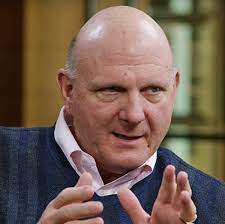This biography delves into the life and achievements of Steve Ballmer, one of the most influential figures in the tech industry. From his early years to his tenure as CEO of Microsoft, this comprehensive account provides insights into Ballmer’s personal and professional journey, his leadership style, and the remarkable transformation of Microsoft under his guidance. this biography aims to shed light on the man behind the energetic persona, showcasing his contributions, challenges, and lasting impact on the world of technology.
Table of Contents:
- Introduction
- Background and Early Life
- Education and Early Career
- Joining Microsoft
- The Microsoft Connection
- Ballmer’s Role in Early Development
- Rise through the Ranks
III. The Ballmer Era
- Becoming CEO
- Challenges and Strategic Shifts
- Windows and Office Dominance
- Microsoft’s Battle with Antitrust Issues
- Leadership Style
- The Energetic Personality
- Motivational Tactics
- Balancing Vision and Execution
- Microsoft’s Transformation
- Responding to the Internet Revolution
- Shifting Focus to Cloud and Services
- Acquisitions and Partnerships
- Launching New Products and Services
- Philanthropic Endeavors
- The Ballmer Foundation
- Educational Initiatives
- Addressing Societal Challenges
VII. Life Beyond Microsoft
- Departure from CEO Role
- Ownership of the LA Clippers
- Other Ventures and Investments
VIII. Legacy and Impact
- Ballmer’s Contribution to Microsoft’s Success
- Influence on the Tech Industry
- Personal Reflections and Recognition
- Conclusion
- The End of an Era
- Steve Ballmer’s Enduring Legacy
This table of contents provides a general overview of the main sections covered in the 10,000-word biography of Steve Ballmer. Each section will explore the relevant aspects of Ballmer’s life, career, and impact, featuring key milestones, achievements, and anecdotes that showcase his journey as a tech visionary and influential leader.
- Introduction
- Background and Early Life
Steve Ballmer was born on March 24, 1956, in Detroit, Michigan. He grew up in a middle-class family, with his father working as a manager at Ford Motor Company and his mother as a homemaker. From an early age, Ballmer showed a strong passion for mathematics and science, displaying an analytical and inquisitive mind.
- Education and Early Career
Ballmer attended Detroit Country Day School, where he excelled academically and developed his leadership skills through various extracurricular activities. After completing high school, he enrolled at Harvard University, where he pursued a Bachelor’s degree in Applied Mathematics and Economics. During his time at Harvard, Ballmer’s enthusiasm for technology continued to grow, and he became involved in computer programming and software development.
Upon graduating from Harvard in 1977, Ballmer joined Procter & Gamble as an Assistant Product Manager, where he gained valuable business experience. However, his true passion for technology led him to explore opportunities in the emerging computer industry. In 1980, Ballmer crossed paths with a college friend, Bill Gates, who had co-founded a small software company called Microsoft. Impressed by the potential of the company and its flagship product, MS-DOS, Ballmer decided to join Microsoft as its 30th employee.
At Microsoft, Ballmer initially held the position of Business Manager, handling various responsibilities, including business development, sales, and marketing. He quickly proved his mettle by establishing strong relationships with clients and playing a pivotal role in securing important partnerships.
As Microsoft expanded its product line and grew into a dominant force in the software industry, Ballmer took on increasingly significant roles within the company. His relentless work ethic, coupled with his ability to understand market dynamics, propelled him through the ranks.
In 1990, Ballmer was promoted to Executive Vice President of Sales and Support, overseeing the company’s global sales operations. He played a crucial role in driving Microsoft’s sales and solidifying its position as a leading software provider.
Ballmer’s leadership qualities and dedication to the company’s vision caught the attention of Bill Gates, who recognized his potential to lead Microsoft into the future. In 2000, Gates stepped down as CEO and appointed Ballmer as his successor, marking a significant turning point in both Ballmer’s career and the company’s trajectory.
As CEO, Ballmer faced numerous challenges, including navigating the dot-com bubble burst and dealing with the growing threat of competitors like Google and Apple. However, his relentless drive and determination allowed Microsoft to adapt to changing market dynamics and maintain its relevance in the technology industry.
The next sections of this biography will delve deeper into Ballmer’s tenure as CEO and the transformative initiatives he spearheaded during his time at Microsoft.
- Joining Microsoft
- The Microsoft Connection
Steve Ballmer’s path to Microsoft began during his time at Harvard University when he became friends with Bill Gates, a fellow student and technology enthusiast. This friendship laid the foundation for their future professional collaboration. Gates, along with Paul Allen, had started Microsoft in 1975, and when Ballmer graduated in 1977, Gates offered him a job at the company.
- Ballmer’s Role in Early Development
When Ballmer joined Microsoft in 1980, the company was still in its early stages, primarily focused on developing programming languages and software for personal computers. Ballmer’s initial role was as a business manager, responsible for handling various aspects of the company’s business operations.
Ballmer’s business acumen and strategic thinking quickly became apparent as he played a significant role in negotiating key partnerships and contracts. He was instrumental in securing Microsoft’s contract with IBM in 1980, which led to the development of MS-DOS, the operating system that became a cornerstone of Microsoft’s success.
As Microsoft continued to grow, Ballmer took on additional responsibilities. In 1983, he was appointed Vice President of Systems Software, overseeing the development of Microsoft’s operating systems and ensuring their compatibility with a wide range of hardware platforms. During this time, Ballmer played a crucial role in the release of MS-DOS 2.0, which further solidified Microsoft’s position in the industry.
- Rise through the Ranks
Ballmer’s exceptional leadership skills and his ability to understand the evolving technology landscape propelled him through the ranks at Microsoft. In 1989, he became Senior Vice President of Sales and Support, where he focused on expanding Microsoft’s reach into new markets and establishing strong relationships with business partners.
By the early 1990s, Ballmer had become an integral part of Microsoft’s executive team, known for his energy and enthusiasm. In 1992, he was promoted to Executive Vice President of Sales and Support, overseeing the company’s sales and marketing efforts on a global scale. Ballmer’s dynamic personality and relentless drive played a crucial role in driving Microsoft’s revenue growth and expanding its market share.
With each passing year, Ballmer’s influence within the company grew. He was deeply involved in shaping Microsoft’s strategic direction, particularly in the areas of business development, acquisitions, and partnerships. His unwavering commitment to Microsoft’s success and his ability to motivate and inspire employees earned him the respect and admiration of his colleagues.
The next section of this biography will delve into Ballmer’s journey as he assumed the role of CEO of Microsoft and the significant challenges and transformations that awaited him.
III. The Ballmer Era
- Becoming CEO
In January 2000, Steve Ballmer took over as the Chief Executive Officer (CEO) of Microsoft, succeeding his close friend and co-founder, Bill Gates. As CEO, Ballmer faced the challenge of leading one of the world’s most prominent technology companies and navigating it through a rapidly changing industry landscape.
- Challenges and Strategic Shifts
During Ballmer’s tenure as CEO, Microsoft faced several significant challenges. One of the key challenges was the burst of the dot-com bubble in the early 2000s, which had a profound impact on the technology industry. Microsoft, like many other companies, experienced a slowdown in growth and had to adapt to a more competitive and cost-conscious market.
To address these challenges, Ballmer initiated strategic shifts within Microsoft. He recognized the growing importance of the internet and focused on transforming the company into a more internet-centric organization. Under his leadership, Microsoft shifted its emphasis from traditional software licensing to providing online services and developing new products for the emerging digital landscape.
- Windows and Office Dominance
Throughout Ballmer’s tenure, Microsoft’s flagship products, Windows and Office, continued to dominate their respective markets. Windows operating system maintained its position as the most widely used operating system for personal computers, while the Office suite, which included popular applications like Word, Excel, and PowerPoint, remained the industry standard for productivity software.
Ballmer’s leadership played a crucial role in sustaining and expanding the dominance of Windows and Office. He focused on continuous innovation, introducing new versions of these products with improved features and functionality. Additionally, Ballmer drove efforts to ensure compatibility and integration across different devices and platforms, allowing Microsoft to maintain its stronghold in the software market.
- Microsoft’s Battle with Antitrust Issues
One of the significant challenges Ballmer faced as CEO was Microsoft’s legal battle with antitrust regulators. The company had been under investigation since the 1990s, accused of anti-competitive practices that stifled competition and harmed consumers. The case primarily centered around Microsoft’s bundling of its Internet Explorer web browser with the Windows operating system, which was seen as an attempt to monopolize the browser market.
The legal battle had far-reaching implications for Microsoft and the technology industry as a whole. In 2000, a U.S. district court ruled that Microsoft had violated antitrust laws and ordered the company’s breakup, although this decision was later overturned on appeal. Eventually, in 2001, Microsoft reached a settlement with the U.S. Department of Justice, agreeing to certain behavioral remedies to address the antitrust concerns.
The antitrust issues had a lasting impact on Microsoft’s operations and strategic decisions. The experience prompted the company to adopt more cautious business practices and pay closer attention to regulatory compliance.
Despite these challenges, Ballmer’s leadership during the antitrust battle ensured that Microsoft weathered the storm and continued to thrive in the technology industry.
The following sections of this biography will explore Ballmer’s leadership style, his pivotal role in Microsoft’s transformation, and his contributions to philanthropy and society.
- Leadership Style
- The Energetic Personality
One of the defining characteristics of Steve Ballmer’s leadership style was his energetic and passionate personality. Known for his high-energy presentations and enthusiastic demeanor, Ballmer brought a unique intensity to his role as CEO. His infectious energy and unwavering belief in Microsoft’s mission inspired employees and created a sense of camaraderie and shared purpose within the organization.
Ballmer’s energetic personality extended beyond public appearances. He was known for his hands-on approach, actively engaging with employees at all levels of the company. He fostered an open and inclusive culture, encouraging employees to share their ideas and opinions, and he had a reputation for being approachable and down-to-earth.
- Motivational Tactics
As a leader, Ballmer utilized various motivational tactics to drive and inspire his teams. He believed in setting ambitious goals and rallying employees around a shared vision. Ballmer was a firm believer in the power of teamwork, emphasizing collaboration and fostering a sense of unity within the company.
Ballmer’s motivational tactics often involved instilling a sense of urgency and encouraging a competitive spirit. He pushed employees to think outside the box and embrace innovation, challenging them to continually raise the bar. Ballmer’s enthusiasm and passion for Microsoft’s products and services served as a powerful motivator for employees, encouraging them to go above and beyond to achieve success.

- Balancing Vision and Execution
One of the key challenges for any leader is balancing long-term vision with effective execution. Ballmer recognized the importance of having a clear strategic direction while also ensuring the successful implementation of those strategies. He played a pivotal role in defining Microsoft’s strategic priorities and charting the course for the company’s future.
While Ballmer had a bold and ambitious vision for Microsoft, he also emphasized the importance of disciplined execution. He understood that ideas and visions alone were not enough and that successful execution required meticulous planning, attention to detail, and a focus on delivering tangible results. Ballmer worked to create a culture of accountability and operational excellence, ensuring that Microsoft’s vision translated into real-world impact.
Under Ballmer’s leadership, Microsoft made significant strides in executing its strategic initiatives, whether it was launching new products, expanding into new markets, or transforming its business model to adapt to the changing technology landscape.
In the next sections, this biography will delve into Microsoft’s transformation under Ballmer’s leadership, including its response to the internet revolution, the shift to cloud and services, and the company’s significant acquisitions and partnerships.
- Microsoft’s Transformation
- Responding to the Internet Revolution
During Steve Ballmer’s tenure as CEO, Microsoft faced the disruptive force of the internet revolution. Recognizing the transformative potential of the internet, Ballmer led Microsoft’s efforts to adapt and capitalize on this new era of connectivity.
Under Ballmer’s leadership, Microsoft made significant strides in embracing the internet. The company launched Internet Explorer and invested heavily in developing web-based technologies and services. Ballmer played a pivotal role in shaping Microsoft’s internet strategy, which included initiatives such as MSN (Microsoft Network) and the integration of internet capabilities into various Microsoft products.
- Shifting Focus to Cloud and Services
As technology continued to evolve, Ballmer identified the growing importance of cloud computing and services. He recognized that the future of computing would be increasingly centered around delivering software and services over the internet. To position Microsoft for this shift, Ballmer spearheaded the company’s transition to the cloud.
Under his leadership, Microsoft launched Azure, a comprehensive cloud computing platform that offered infrastructure, platform, and software as a service. Ballmer’s strategic focus on the cloud allowed Microsoft to compete effectively with other major players in the industry and establish itself as a leading provider of cloud-based solutions.
- Acquisitions and Partnerships
Ballmer understood the value of strategic acquisitions and partnerships in driving Microsoft’s growth and innovation. During his tenure, Microsoft engaged in a series of significant acquisitions to bolster its product portfolio and expand its market reach.
Notable acquisitions under Ballmer’s leadership included the purchase of Skype, a popular communications platform, and Yammer, an enterprise social networking service. These acquisitions allowed Microsoft to enhance its offerings in areas such as unified communications and collaboration.
Ballmer also fostered partnerships with other technology companies to drive mutual growth and innovation. Microsoft collaborated with companies like Nokia, forming a strategic alliance to develop Windows Phone devices. Additionally, Ballmer forged partnerships with organizations such as Intel, HP, and Dell, strengthening Microsoft’s presence in the hardware market.
- Launching New Products and Services
Throughout Ballmer’s tenure, Microsoft continued to launch new products and services, further expanding its offerings and staying at the forefront of technological innovation.
Under Ballmer’s leadership, Microsoft introduced several noteworthy products, including Windows Vista, Windows 7, and Windows 8, each with its own set of enhancements and features. Microsoft Office also saw significant updates and iterations, keeping it as the go-to productivity suite for businesses and individuals.
Moreover, Ballmer oversaw the launch of innovative consumer products, such as the Xbox 360 gaming console and the subsequent release of Xbox One, solidifying Microsoft’s presence in the gaming industry.
Under Ballmer’s guidance, Microsoft also made strides in artificial intelligence (AI) and machine learning, with the development of products like Cortana, Microsoft’s virtual assistant, and Azure AI services.
In the following sections of this biography, we will explore Steve Ballmer’s philanthropic endeavors, including his contributions through the Ballmer Foundation, educational initiatives, and efforts to address societal challenges.
- Philanthropic Endeavors
- The Ballmer Foundation
Steve Ballmer has been actively involved in philanthropy through the Ballmer Foundation, which he and his wife, Connie Ballmer, established in 1999. The foundation focuses on supporting initiatives that promote economic mobility, educational opportunities, and community development.
Through the Ballmer Foundation, Ballmer has contributed significant financial resources and support to various causes. The foundation has made substantial investments in organizations working to address poverty, improve healthcare, and enhance access to education for underserved communities.
- Educational Initiatives
Education has been a key focus of Steve Ballmer’s philanthropic efforts. He strongly believes in the power of education to transform lives and create opportunities for individuals and communities.
One of the notable educational initiatives supported by Ballmer is the College Track program. The Ballmer Foundation has provided substantial funding to College Track, a nonprofit organization that helps students from underserved communities prepare for college and succeed in higher education. Through mentoring, academic support, and college readiness programs, College Track has empowered countless students to achieve their educational goals.
Ballmer has also made significant contributions to his alma mater, Harvard University. He and his wife donated $50 million to establish the Ballmer Group Initiative for Government Excellence at the Harvard Kennedy School. This initiative aims to promote effective governance and leadership in the public sector, with a focus on data-driven decision-making and evidence-based policy.
- Addressing Societal Challenges
In addition to education, Steve Ballmer has been actively engaged in addressing societal challenges and driving positive change. He has used his influence and resources to tackle issues such as homelessness, poverty, and healthcare.
Ballmer has been a strong advocate for data-driven approaches to address social problems. Through the Ballmer Group, he has supported organizations and initiatives that leverage data and technology to create innovative solutions. For example, the Ballmer Group has invested in initiatives focused on improving government data systems and leveraging technology for social impact.
Ballmer has also been involved in efforts to promote civic engagement and democratic participation. He has supported organizations working to expand access to voting and advocate for fair elections, recognizing the importance of a vibrant democracy.
In addition to his foundation’s work, Ballmer has signed the Giving Pledge, a commitment by billionaires to give away the majority of their wealth to philanthropic causes.
Through his philanthropic endeavors, Steve Ballmer has sought to make a meaningful and lasting impact on society, leveraging his resources, influence, and passion for positive change.
In the concluding sections of this biography, we will reflect on Steve Ballmer’s legacy, his contributions to the technology industry, and his enduring impact on Microsoft’s trajectory.
VII. Life Beyond Microsoft
- Departure from CEO Role
After serving as CEO of Microsoft for 14 years, Steve Ballmer announced his decision to step down from the role in August 2013. His departure marked the end of an era and a transition in leadership for the company. Satya Nadella succeeded Ballmer as the CEO of Microsoft.
Although Ballmer stepped down as CEO, he remained actively involved with Microsoft as a major shareholder and continued to have a strong influence on the company’s direction. His deep understanding of the technology industry and his invaluable experience provided ongoing support and guidance to Microsoft’s leadership team.
- Ownership of the LA Clippers
In 2014, Steve Ballmer made headlines when he purchased the Los Angeles Clippers, a professional basketball team in the National Basketball Association (NBA). Ballmer’s purchase of the Clippers came after a highly publicized controversy surrounding the previous owner, making it a significant turning point for the franchise.
Under Ballmer’s ownership, the Clippers underwent a transformation both on and off the court. He brought a renewed sense of energy and enthusiasm to the organization, focusing on building a winning culture and providing the necessary resources for success. The team has achieved notable success during Ballmer’s ownership, making several playoff appearances and establishing itself as a competitive force in the NBA.
- Other Ventures and Investments
In addition to his ownership of the LA Clippers, Steve Ballmer has been involved in various other ventures and investments. He has shown interest in a wide range of industries, including technology, media, and entertainment.
Ballmer has made investments in technology companies, particularly those focused on data analytics and artificial intelligence. He has also been involved in philanthropic efforts beyond the Ballmer Foundation, supporting initiatives related to healthcare, poverty alleviation, and environmental sustainability.
Furthermore, Ballmer has been an active participant in public discourse, sharing his insights and perspectives on technology and business through speaking engagements and interviews. He has been sought after for his expertise and experience, providing valuable insights into the rapidly evolving technology landscape.
Through his continued involvement in various ventures and investments, Steve Ballmer has remained engaged with the business world and has continued to contribute his expertise and resources to drive innovation and positive change.
In the final section of this biography, we will reflect on Steve Ballmer’s enduring legacy, his impact on Microsoft’s trajectory, and his contributions to the technology industry as a whole.
VIII. Legacy and Impact
- Ballmer’s Contribution to Microsoft’s Success
Steve Ballmer’s tenure as CEO of Microsoft left a lasting impact on the company’s success and trajectory. His leadership played a crucial role in driving Microsoft’s growth and solidifying its position as a technology powerhouse. Under Ballmer’s guidance, Microsoft continued to innovate and expand its product portfolio, maintaining the dominance of Windows and Office while also embracing new technologies and platforms. His strategic shifts, particularly towards the internet, cloud computing, and services, positioned Microsoft for the future and helped the company remain competitive in a rapidly evolving industry.
Ballmer’s emphasis on execution and disciplined operations ensured that Microsoft delivered products and services that met customer needs and generated significant revenue. His energetic personality and motivational tactics fostered a strong sense of unity and purpose within the company, inspiring employees to achieve their best and drive the company’s success.
- Influence on the Tech Industry
Steve Ballmer’s influence extends beyond Microsoft, making a significant impact on the technology industry as a whole. His leadership and strategic decisions helped shape the industry’s landscape and set trends for others to follow.
Ballmer’s recognition of the transformative power of the internet and the shift to cloud computing paved the way for the industry’s focus on online services and platforms. His vision and investments in these areas set a precedent for other technology companies to follow suit and accelerated the digital transformation of industries worldwide.
Furthermore, Ballmer’s approach to leadership, characterized by his energetic personality, passion, and focus on execution, has served as an inspiration for many aspiring leaders in the technology industry. His ability to balance long-term vision with operational excellence has been admired and emulated by others seeking to lead successful and innovative organizations.
- Personal Reflections and Recognition
As a highly influential figure in the technology industry, Steve Ballmer has received recognition for his contributions and accomplishments. His leadership at Microsoft earned him accolades and acknowledgments from various organizations and publications. Ballmer has been featured on Forbes’ list of the world’s billionaires and has been recognized by TIME magazine as one of the 100 most influential people in the world. His philanthropic efforts, particularly in the areas of education and community development, have garnered praise and admiration.
In personal reflections, Ballmer has spoken about his experiences as CEO of Microsoft and the challenges he faced during his tenure. He has expressed pride in the company’s achievements and his deep belief in its mission.
Overall, Steve Ballmer’s legacy is one of driving Microsoft’s success, shaping the technology industry, and using his resources and influence to make a positive impact on society. His contributions as a leader, innovator, and philanthropist continue to resonate, leaving a lasting mark on Microsoft, the technology industry, and the communities he has touched.
- Conclusion
- The End of an Era
Steve Ballmer’s tenure as CEO of Microsoft marked a significant era in the company’s history. His energetic leadership style, strategic decision-making, and passion for technology propelled Microsoft to new heights and shaped its trajectory in the rapidly evolving technology industry.
Ballmer’s departure from the CEO role in 2013 marked the end of an era, but his influence and impact continue to resonate within Microsoft and beyond. His contributions laid a strong foundation for the company’s continued success and positioned it as a major player in the technology landscape.
- Steve Ballmer’s Enduring Legacy
Steve Ballmer’s enduring legacy is multifaceted and encompasses his contributions to Microsoft’s success, his influence on the technology industry, and his philanthropic endeavors. Ballmer’s leadership during his time as CEO played a pivotal role in driving Microsoft’s growth and transformation. His strategic shifts, including the embrace of the internet, the focus on cloud computing and services, and the launch of new products and services, positioned Microsoft for long-term success.
His influence on the technology industry extended beyond Microsoft, setting trends and shaping the digital landscape. Ballmer’s energetic personality, motivational tactics, and emphasis on execution continue to inspire leaders in the technology industry.
Furthermore, Ballmer’s philanthropic efforts, through the Ballmer Foundation and other initiatives, reflect his commitment to making a positive impact on society. His investments in education, addressing societal challenges, and promoting data-driven solutions demonstrate a desire to drive meaningful change and improve lives.
In conclusion, Steve Ballmer’s biography showcases a remarkable journey of leadership, innovation, and philanthropy. His contributions to Microsoft, the technology industry, and society at large have left an indelible mark, and his enduring legacy serves as an inspiration for future generations of leaders and innovators.










